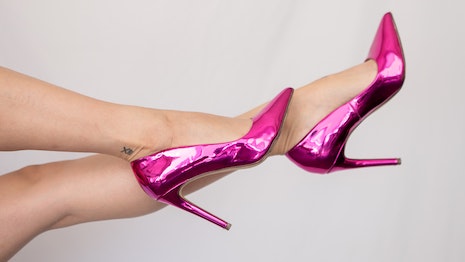NEW YORK — When contemplating what women shoppers want, brands and retailers must consider how years past have affected the landscape and what consumers are increasingly prioritizing.
During a panel moderated by Jennifer Woodring, vice president of customer experience and brand collaborations, Luxury Portfolio International, at the Women in Luxury eConference on June 16, retail leaders discussed how consumers are reverting to trends like dopamine dressing, dressing up and returning to in-store shopping. Younger shoppers are defining what the woman of the future wants, which stems back to sustainability strides and interaction with brands using technology.
“We've seen this joyful explosion of what some people are calling ‘revenge shopping’ or ‘revenge dressing’ here in the UK,” said Katy Lubin, vice president of brand and communications, Lyst, London. “People being so excited to buy new things, to find new creative outlets for self-expression, to get back out there into the world and to look fantastic doing that.”
Women in Luxury 2022 was produced by Luxury Daily
What women want
Retail experts acknowledge that it is impossible to generalize what one group of people wants, as everyone has disparate tastes and holds different backgrounds. Certain popular trends are permeating, however.
Women are enjoying "dopamine dressing" – a type of revenge dressing where one chooses to wear clothing that benefits their mood. Consumers are also enjoying the return of going out, fashioning dresses and high heels.
 Women are enjoying dopamine dressing and a return to in-person shopping. Image credit: Simona Todorova
Women are enjoying dopamine dressing and a return to in-person shopping. Image credit: Simona Todorova
A return to physical retail has been prominent. As lockdowns and restrictions are lifted, more consumers are vaccinated and many places return to full openings, consumers are flocking to physical locations for shopping experiences that they missed.
Creating a positive in-person shopping experience can help build consumer loyalty and connect customers to omnichannel experiences, leading to more profit for brands.
“The spike to return to physical retail has been phenomenal,” said Natalie McGrath, vice president of marketing for North America and EMEA, Afterpay, Atlanta. “I think this is a real opportunity in the luxury sector [to identify] how do brands truly build that omnichannel strategy to engage that consumer — what truly is that omnichannel proposition that is going to build loyalty and engagement with the consumer?”
Utilizing data and gaining consumer insights will also be helpful in determining what they like and which trends are dominating. Brands must try their best to try to understand and get to know who is shopping for their products.
“Just start talking and listening to customers, and really trying to find those killer insights that are going to set you up to be able to deliver something that is special and unique and mind-blowing for them,” said Lyst’s Ms. Lubin.
Millennial and Gen Z consumers are slated to make up about 70 percent of the luxury market by 2025. With trends like dopamine dressing and a return to dressing up, many consumers in these age groups want to showcase their looks and connect with brands, with the Internet remaining the ultimate means to do so.
 A Gen Z favorite, streetwear is becoming more cognizant of sustainability. Image credit: Lyst
A Gen Z favorite, streetwear is becoming more cognizant of sustainability. Image credit: Lyst
“What has made the trend of [younger generations getting into luxury at younger ages] more visible is through platforms like TikTok, where you’re suddenly exposed to this whole new generation of creators and people who are sharing their love of fashion and their self-expression,” Ms. Lubin said.
“[There is] the fun of dressing up and wearing clothes and engaging with brands in a totally different way that is much less controlled.”
Seeking authenticity
The female shopper of today, and the future, is also expected to continue prioritizing sustainability. Consumers are looking not only for environmental initiatives and sustainable ingredients and products but are also wary of concepts like greenwashing.
With Gen Z’s buying power expected to reach $33 trillion by 2033, this cohort has a rapidly growing influence on how brands go to market.
According to the 2022 insights report from marketing agency Adolescent Content, 78 percent of Gen Z is skeptical of brands’ commitments to equity, diversity and sustainability — indicating that they do not trust them. To foster a mutually beneficial relationship with Gen Z consumers, brands must recognize their weaknesses, realign their values with today’s consumers and reimagine what it means to be a brand that can withstand shifting cultural tides (see story).
There is a massive shift occurring within the luxury space, as governments and conscious consumers call on financial corporations to strengthen commitments to environmental, social and corporate governance (ESG) issues.
According to 2021 data from Positive Luxury, the link between sustainable business operations, commercial performance and company valuation must be acknowledged. Innovation is moving from product lifecycle information toward genuine innovations in environmental practices, such as sustainable production, manufacturing materials and techniques, as well as social practices addressing inequality of opportunity (see story).
“I think [sustainability practices] really need to come from a place of authenticity, for brands in terms of the end-to-end way of operating their businesses, and it can't be just a marketing campaign that lives as a one-off,” said Afterpay’s Ms. McGrath.
“But I think [it is important] for brands just to be very mindful that we can't just greenwash this and it has to be very well thought out, with a deep understanding of how they get to the end goal.”
{"ct":"BiPzKvAILY\/T8OowAU9ZsEN2D6myLEXGp7mC7NflnEw6+CWujtRrVvyu5H3NJ5RhtB1+gXvXblhhGL8wrSsUq+Zyz\/12cxAwbTi6+wTlItfLYiI1yc1phl8Tz4XrxiysShCrmEpq7v5uxvwmkZ04bT0R7pXbXlZuEehQE46sEWZgNP9\/titDSIZOmkGgPBW5UmCcKtHOkf2sAe4miOOLfww24TTAeE0EfqDF4Vl21I8IIzFx2zWv0S5ns\/eVVk1LCCLe4xiYBFOtxzHv+olDJhmhXc7bCs\/HgMvo5fojM5xLiwytSMyhJpaGF8Xy8v3u2DGIKyomuNu1knFrKKaJmQMIXPKmWijdhsI1+AQrYTy2QtImBFzMOHMEdJK8OtG\/mEQHw2dRegiWATGPZJodqrXnWlkmc954JfROw6UswnMMXldUGIFgZt0epIOewBSEgjzGen5TfgZawln5EqX2pyknTIdN2ejq4Mt2twAmTHB6ki2zZGWMVlxdtHId9OKP6RXzL6X0cD+4TrJpN4U9FHdGjrQuWrNahe\/XTSR8ciyaPWzoLIRIcb0udG47v06+ya9GQTOSPd9MX\/m9\/dtH+fzXCqQCsuAMVWNT995E3xnShe5a352kQxuIpqG\/gL3zialJkInvrte3cTiDHimF6xDGupzCzA+HsUsKzq8Q5rq8748\/03yBioxirK2B9a8jB7VjJSvDh+GT7PIg0kGJHsfjk\/KxgcB1oD4wuLtJvizF2qiAxVMl9gCrBuLloeuF2O5r5uRwquZn7RhEyk\/cPZJkZ7RdDk1YEUQ3AVS87uzXPsVduktL6wyJCIpJvmXxoKM+EhQooor8n4SndHP8WKq1Qg4yHKyc2kEGvHHT0pJbPAV2yXBn47nPB1nkSgosmc4W4v54JWCPFm7IOGo++vcoXBjAIuJfPc6G4Lfmq\/pjsRI3FLvEAWiG2pmDtX5IXM7Wq2fjIcmeza394IGyZmCEg1sm56O2DLiy9WcuOgsUgxmlVbHXHtnUehyMvl4fU+OTst0PVVt6KHmXvNb8cAbIIdTwnmar6uQTADOeHPg36rBLdohmAhAk7mWMEeUX3bWKjHbIpL6sCIB\/hCPhZY77a335TdDmCFW209OPcsYeKTKVf6n1X7WpwwlMTsjxS\/TUUc6DGKurBsGfaNpT219wAu6nmbvuA7jMXsfyg6AIumMvna8Za\/hr7PYwnKmr73n4szp0K5DDUL1z1ern9K\/zMKDYcBxJvMvl3\/VNnwiWRspnXU1jj63PJIdMCuwm8RcpOxeSTqGaYLEXRFyfdR\/pJvpy3ImyBZ0+pQeUER+MfHK85cinVwEK086mceooIdP1VrCcVWIaYTW+YQrNgOm+XLXvtiACwbbGScMBF731uOGMwHdFSiVxvjtGAMPfoy+zK4yfKMLdsMIbSpzmppTwklSNhn6yjO6m0wWr2PezH6Nb5oyBc6xOuvzco\/gpTOr9JB7dyXX9svBLzv6Q25GT3bavVFoNQS6RvfuczZiS57MaVZKHbJ6hJUOPhN+algvwMkuCFw6\/ldlWGp2vjPfHbphHN\/sr2Vr1sg53C1Vz9WDNxabWm6Sda2sz0RRgAf9oAmNg0cZZd\/QKdEdWDHHTPsyYq+YXKRjdW\/sq83bSnKa1p8FjP\/wQm3GC2eDsutUhzyynfYUvzMrJIb+pBTdi+p9RaP6ZDGx2wBsHTlUCrqhwndl4utsNOrlf85dhdWyRD3P8QIKaP2igHvRpLj8nMChseogDemLhz3v7E1FArFj1anrCKGW9ZY5X1fp\/x828RuKJyqdAFRDkRrbyQykscOu3a9MCJPWbksTBA6UBj7mm7+ybQB2EMbu2g4MC1vKPCyyJH33MjVdvpR+jzCBqJzEPJZ3NG2mZZ6DrFfSog6OmOmcJMjKOgRbNHN0bJ+q9pNmHN9yxlRMaWonYHY\/+IsUCz5ROKbqX00ZPsKuYO3gVDG6MXht0Mjjx3b59M77E23G7tjeXo\/\/juezi5ieea9avpuEsFxJSFWbLThYQoGhEm3tY4Rt2FmOPsYs3dc5TuZ3IAIXfOupx04EnIsD10oarq68ZIP3aOlOBwkJE24PnGwId3UGDhxT8EgQ7ysIDd1QC9tTOfaXV8bnek0b2yp+Z9SaC95VyTKXs4TCu6iCLVdC47PoGYxOPANLAThg0J5Rqxl56wrTY441LS6bcRpyHib1GJiFGsW0hTncumZyYI\/JiVh28rAl6Q0ep+OvLm6DZCdiqCKsDu4TDu2Mb6JBt3mliDqp48cfA6Qfyo5h+0ORZETqKw3abFDiR1s5HOusxTAcMMq17GvI+Vs6ygTLIMTmm8pOZMNOb8Oi0v4Lj5yUmQfWqQ7CrTRENbla0vm77U0MNG4hnbXUpnQhaxPyyf1wqFYTwwnjlslrqKDjLNdwnzWT1SmRwIYHs7JgYWQ2yurP19M3gWaJB+vfKTYuCjO2es6oI3j1NEfcHuUuu+wsuYijK17nNsW0UY20NUT9cGP0L1mGg6lzXWml\/kCSxooJX7TYxbYXHTIcosCEvpEDBl2fYjELT4u+qlNp4ORZad2vrmCHK6pLP2KjjOXxWXNqr3vOtxhbATk0HtGgP7SLhhmcToO+MtOx3j9\/69abAf63Po++kL5Jjv5smV7UKxdyJcGN0JcS3zJw3p8Oksqzfa1rZ3lhJMzd7LxVVFD3dIAiVtzIF+xHLB4amg74JluMPlNHX0WEolJJcOh9peHe47+SrrR2QcVOWyNd\/MgxJgL2\/mMsPngH7u\/5pUvfXui1hGagIFwozgRxk3HpVDEtFv6Gz06mVXswMinE7fbFBr1MJLnBUOxJQZ8Duwy7bEEaZOUlzia96+UfhlbaO1Uf6vae3WJJebDE8X8V2l2PWjjFFARchrih5OePaF2zCBbTKrHQ+W2TOxSQOUbueGyPpvhOGENXU89deXEFB2hKLGDbSYFFNOAq\/VqMSsdQJufXuKZKaLqYdP7H43SdA5w1zdv2mShrbBGVJ8GXVztafDvHgHy7jCFjpYhXeRbgjGLhNWhyq\/BqwXCC5U5sNWrwYgLFyU8f1yvEV7tBG4gCJsAzCQyHD6OEsjiLtIP8XHZURUfwKOfoFEbZctVZoFMi4qywKfnj1IqzPufBeKO3kn4yXddlz2NuqS7ZztqTXi2nRt7+icdY+hIz32aK3Z\/RjFHGklrUDe1rtGvI6DIoHtu7K67T7GqWD0AEh3I9mqtQSkxEad\/DE2kttaHJRcoEVQSKr5l2sinR6dIzX\/0F9KfQXhUhOpTqpAogdz0lDJKLWjVMpFQqFWJz99agMvP\/Flar1qjw7PfwIpX1Pus6BSqZ0cYt+0CAPbQAuQa5Fd51grePxgt+HFzF2zF4ehF90gSp2d6m5vZ41R3Bjor6VhLmi7IUKNSki4vrrIErmAgAKzD4nHoCYMs43m0sdIpDGkXXaiOtvN3FEA+PBvdpoZ8PpR5nZp9Cag1h\/1DLboqeNd4yHaGGxL9mnnD0tX\/TresExhanIfB3ZHTMrXzkcExxAeBtbLEpijYRU70P2Nkicw\/KVQ0YGa6gzhbXB7GO6w0xIHpyUyzxHenBgfLBc0jo3OqLNi9mk03mwyXkO2GFS1vrrDDxigyPovIOM\/f7v5MN0BVVdy9TONJKXqSE0ChjuYToEl9MCoEKn08drz\/OT5ITeD2iKDyJx3laoyEJ7WYwTfywJc6HXxbdsAvmjcO0FS5zD8EyQt5GizHLYhsbs53xqcNyVAc+2jE0D2He3VqnNZjEVV6fCTrwvRNjx893y+W0dZH5\/vpC\/vF4MdpHkfmdKw9GoqdA6S1EvBxiWpMKOhsTsYG\/4O1XLVzmmWG9Jdq7IZb\/zV6Gj4wqgAS+SwReh6XwiufDtm2hvka31jAaUogIG+5oJCo2c\/LRuiyAU6ernHIwN3\/IqfjOrSMXiHzaZLMUf\/DRKaIIcrpGqLSQsj\/3MRLpiTnWokZN2RefPUHE7MGij4R29m0ZvSx2fuo0b1Kp8vINuWHtXs+LmFbDpvOmKXDe8DOTGqiRyxOpEYromoASuT1uip8DQvRAUjUcrrpFGEL7CUXCd77ckuVZ0hXgYvYbLFnDQyPALDUhP7CZ\/5iw36AEbiexNO0NxugTm1GW1iuWZSlZtd3Q9ZyryoTpGGoqLF9ozIf3+VNtghTh7fS+idKjc4xZu9Wi8WgfW9xkTPJFGduIAGN19Wcr0grJFCddwa\/+dP+RIRfN6acT1CO17M1eLJ5kTYPGflUvbJPaQFUmP+MqoisJhaJcO8fBI0TPE3VYMtcCxVx5D\/K625cZK8XZOiIE9yNqE6AUND5m9UQl2WjHmL3mXjO1kcCy9UoKOUBI7+SheQihKwcVoncSyiFjpghB3UieWnqlUdSuElpam2mJkmhjTmG1QsSHqvZ2\/9GwCYMhHiacrMLedJjnqyocY3UKxPGbZJZPQNwmhlzl55LZGTHyVKn5vNj\/QhOpmsfgLjSv0zyWj4rpoe2aehD1ZvLFtNlshY6tlC\/yDi7Ey7aZCs01knGVQ1c6U38JABpQaqxVL69t9jtBLOM8JuTIJN8VpZOXOmpVR3IBlojY25sfliViN8IWI5STjq\/GsvfnfHQ8qrRk4slVjuGZJh7JM2Mo8BI0VacBfxf2GVqcuMSjJ0+H4\/o7d4u\/EFvayGjP60SA+mubb\/oFnYwGGQvTZ\/mEgG6UQwmr3xF4e9suNmtZdXbOuT16kgF2hJplsRupXkNzV5gPyqHrWkF6c8up1uxTvI0obkTFxyp2YGS\/bvfxn2MeZVKSxGPhEjoQQrdxBzPlTfAKHBHs4lT8pGRiBG3sMlXT+4YWGwElpz5gFBuqZ+FLkbwhAnDd41vKKeT\/Hwtot152+yDqf4G0G31EMTNZk\/A9nWB\/14WJpNHiMgt5nS2LCkeHjyNBJQsGKcruA4xBnQQB+ofAoeoeDOe8q0FvsMx0zw6+8pYwn0JYrP+ZcQHEHuXjTCEEGSmeA4\/6Tk9nX0ogE5tMPTHl0FB7LIdpL7uuYF646PQcXW50tFDfkVjIaHImEPYxMBe\/BeezMwRkAYb9vMr1B72gyDEM776w45EYwGLQWzV3RMRHncdOuby63nfHxfSkFJqFFhXI0vhE58Cus8T0ij++4Yfs+j5MzHiYFjMOv7GQ\/YkPeGyl0SSGE+prNMLzQiv0KznoyUDUgrf0CPvpc0FSTkkcJ2XET4NarIcP8fZLS\/OGIaFFLLuDxU1qVlMRB1Qf1WK3aIKyi357flbckRYqNAmaG6IYJXZh7dFlU9H9SUVbrh3SUiiQ+7Ge+5AmOA2UOYuXQaTDL8c3Aj5rZqmmP+f1XuMKr2cL3kZkXzr3Gzo5kp1+AXAm2+Cl0C6mgGjbYbqUziOhWQ+30LJ3um3BpRIncFew9jhx4SaVncEqXsQHcF2+QdvLgBxYSC1EV8qsm1KZceTJS89S1tqa4cQG+K1GDT5nCDHP72sVa+CBKSKqZ8+UE5yKGTuGbSxUntGaYo45XoJnMCbcBxEKNtxrcZ\/igF4x6hViGL8Sxprn393ial2vNeyeDy0Kge\/8cuay\/MoFvs794tM9jRt0gg1+PH+Gv9\/fPFEs9dlZL8rdGoe2g87O\/mhu7Sxp51MpA9jMf6EfzkhVejkWbVm1U8wuWcXB\/qkgJ4hCg2s+gavyrCNCvn71vdpfdPy9IY0uakvAUUpHGq9Z6hYc1b9ab81omZr6NwvETdaWKU+klUIh+YhA7iit43UgunoQZikU9xYLqez4VAlvcnJyYwkZV4ImTH+VVZU0DWKiyoG1AIRQrOa+nKxCiXodM1urtrGChWzfN4mFQy9TLu4hlA+SF7KA\/3txYzCW3k4tlWaVa9CQj\/GptctuonrqM+S\/DxjhgN9ha\/\/MLNZjr2BXJNulvBleQizSvW2ZAGCX4JgdYBNMVaCfgiC2xSZGdh+w1y5uhybQqjwzLJNwJgJkT1UYgpo+obGe\/VFKJz0aI4eUuWTS0r6D\/4j4TmzdoU2QTRdT1W8EbsCcOy2TqiPi4GcG4Pm+6hb+ZuomlfTFAId2DPgQOSFu1DrMVDWAtnn6CQpYMqb9AdStCuNzI\/ZNaGMk5xY9FQwPN1La+0nuNKT4H\/G3bDrkZXa83CLPI2pDPnVl9k6+IgW0lKEocJGPNx5sM03ZHyYEpWBT+0\/6e326QQRocUWuc6wD9HJnTJ0o5o61PhBp1ysdUA6Cw3D1qNNbpArPty6oIysP\/7P2JnnfKT5M5U5kGuMQAkoguRXn74CVqnh\/UffCnB+F7SsahT92I2oKWbMSGws6Js9Mz5a2yUcagz2q+ttyRagQnJqX7G12UcEkDgtofM1EqFyLXNW6iVJxBEfLK6gjg\/UwRd+7zjMoekYw8f6t5oHi4GrpOi4WxtDRXzhqMrh\/hSUR1n+z9Vi87NUuNMt\/BVWd0+M7IZMCGAcrlCS3tJGqBOxoP394UhcjNLxraGO0CvSWLKYM0cUYQ+9EtAC1JjVuNHfmoPzrQTlfwkqKpv4j9YnU0swUXbyZzZINHCyjrl3o\/1946svB6ergnoGvIh9ovmNxNzzgeb6ahtcGAG417pc1clKBT6h77+f8SuXNpy7MYxCFkqR\/2SexYbHTb4egadBxlZ+PPLJw7X9qVBC4LcQbu+MUZ3Kl8ZEFWnwjccBB5TA\/SBWhftJ84I8yfXS\/M4gmnBR3h2fQJERJxjNSAJIp1gjvpmnvj24l3SrDHflanVmI2osolAyHmbetKrWdNj0rnoWBecq2bQ+U7shTPE7D9frSjoEjBFoiVaq2K3gxWBR7KPtirvcRHo8zysVligKb4xKSSfi\/gc\/j7rYotMANmRpeDHRjcF4LaZHARH5dHF8nlOqunWV5XeGYzLVNGF2Z8BOKQUFoHPsYlubozePSewfS4P0fgVNA9\/yVSp\/doD+RZLOy55bnh5p60pM6VPHPR5XcUavjEO190ITv1KQzqQBwJFGrGC41VUpA9rCXyEpQC7ReiL3AXMcZyHffQz11hS7qraqFUT5U1j6zhLRKZLCIHfAjyU8rbUOMxIeN5TKXWrHKBUM8u5gB\/IJpEbetWSkFwoJ5y\/JiTwyejZbva+6eNmz14HxiQ2c\/v9iis38JqDpvp\/39NIZLfRkKS1T0a\/fSw3J7dLmnzj2OT1he2q5yP6Gkz2dYJ+Swoz1S+Dqd8Bna7ygghsC9ZX66ggdTnPCffzx01pXAqU1ZZ0QPt463FKXiOtbyyIXDP7FFu7A34JdCUIf5RfkLqB3rRYPiJq\/MjdbU5TjH1eZydB0w5gSX\/mtfUuEYQ4D4+p5Nhy\/e12N2YI5fv9o7WR\/7jZptDwTyEitGg0tgoSINoXotyY8ivjdjOYW2Fltj7leHUDJenDqd5Mf9epbw2\/v8qQaHI1jqoltro11zh9mINU6kn8duo0Tx8PFcc55FzCfcVT8+7Ex8zOLo6h1M8\/luf0GpHTjP8ByWNO5gDx5Px4oIxVXeMhjbCzVaqc67dCwX2uTbhaDl76XEuZnfoFJEiOFoCdL0cWcowtQDEYFmlwOiV1T29Ylm0LiunCc7LnY4h+MmvlccgWjvD8t7uwT271\/+WwJZU0gdA9tLKyxwCAIWIM0hhpj\/81UJ\/gKPNc1TJjX4jGtgQH\/zOZxl+H8H9ME2ozrx0Uo\/+RdIlPG0lJgIWj4Ci4\/px35MgDO18OLsCxSmNeZPyjNy5lTVqn1v6jVclBqalUFshjutPcMlg8u2zqEIkn5PoIre8Hf2ZaEdSQzqQ+7TwuR9VMlq5U+VPdh\/7t+SIi+rgfaalW685z8MdP31SO9cPXRqNssJMjKZyry8ZpR9i\/GOKRWjl6ahmt9VH7kyWqzqOurTnad25aM0zM\/8bkYB1+BwsganrB3iZfsRDS6tZ\/t6iAc2mSzYO86IFvZWgOIEOgnpqrU8UuWaI\/iamAXhehkloDYgeAT90in6OZRqnw0UCGItmnxwXfE96etd7EI73fZYF7BGkj0BXdFCCJntMEoR77lIRWbv\/8OMvzjLrzX9\/TejUaD0LgzDw56QJTpBFsjadXYW73bNf6AfpNDvHsMdZACzxG1xjIFS9tc44kn6aGTD25cyrfJ6HHuUmy0IJ1mBBION\/xsTwLtrXuOzIqUHgdWKW5XU2CymY1RRoEpmGtXdlya7psB\/8F\/K5NbgRvcfunEe9nmT5TP3CrV0\/FhAaANHACAz11EJSIeEEw1qDGguRUGInENoRCgmHZUB+Qc1\/sUsGLxYStOtX6p\/wOYU1fh+tp935odiXIEZ\/oIoWyOZ85MdpLN+TVeGtMaCB9CW\/cRGDru9BDUlq7ZHuHmexppql5npP0TDdSn64K7OenmSc+NQwMN1cOiwCzILDKcTz8yl\/H89XLigJifim9Lefbr2E1xNfQEjJOG6CGZPRf7tiBtE0VhyWYfSwbRCKgQPZnnBLNdxejG0ZLYMZB88mT\/dJcn3mXuP2I3fC\/28qe2JfyjZNSZEYga\/sTQaAHiRyYqsuDOOuYhf1g3AO7fbl6w3pEj2dci74tJyrOtwiV4kVr6Uh2G0OIBo9hfemjWvAnt4KQ\/MznUKu2ynWF2qRniWdQfGzdG2mEuQjaMGNFQ9M+z4dUn5x4Gq0TJEQuWH\/pfIPgFHjsbE4aCcwo3Z9C56yPAeeUGPyH9kM+p4haY3H7CdAPvS+jfU+Dy\/E\/KJ9U3Xwxe2CGpD8m6CoryFkt3qGZLvmMSFpVGGb6mTdA8Fcq3+CT4YNmL\/9iJ4rHvsxrU7xCB0Y\/k27LaqU\/tEiEUzg8wcgS\/BpLPJ7BV0DsMgOVUOWv25t8+k8MbuxPoYREnKPp1k6S+5+oThyv7HLfS0B5CvdrL2nAtQ\/NEhn41mSqmO6kXJ4pUiCsWakrM4srFyZ0q+n1\/+5Y81l\/I+mESFJCJFFyWy0JtgDFJW8pVSgXHfX1tb+BXwBODpZrJd7ULYk1Wd9RLS7oS+\/N4KuuPRJfXKVMcaJXL2VzSkzPgpYaEXirrhpBoY1ZtvdeRgwYnb1Aww2rPzwyLgPynJPohy1VLJ2OFsad7i643iw3vQtEY+nm98Ii6GwWXIAlNmV4iMHxCXyromFlAe8ukQiK\/22ogKFzY4ssSyeD65gMCyctHWarWGA6oqpGtbfw9BOtdJo7q\/fH+Ns\/l1bIpsk8hOEQAqLAdkbzaAZyBk6wn0EcZ7EGzaDLE83\/vXw4tXFhmkR3N\/emo2zDuzdkdBiDo\/THIVxPPf84sWdPrtB8CbefFWFdj2ebqhlo2L2xEzTB8rQceVuuQTCyi3BbK\/88hz8eFmD5Q7xcH0PlfmeYhHcovOG52XaKc10TrWC2Cd\/+GQwJ7PyjVfCUtZQ8sZOK6+u9JwLmKe7iuQ+vnMhMlc4vVzNA5J4IH75qWuL2vQ\/QpSF+6bsr99Rrwb7VdCjNagfyF73U0D+q0NrqXSK1LDXehI07FoT2aR\/jXZ0m3wdu8+h0Pu+neKAtFSFsITmIeJzzCfJwM2d5l11xUnFuJdGEhXZaV8BuCQK0CK7KfZaHefjUmZ4UuSJllEUfUXzu2\/Sm5KWsNscLwl50H0TxN346HJJ17C0zTFk\/Co3D0bpap4SIwRPkY0HjyDtzbnbocU2oynNxmtTrn3yxT5l4tAHY1K9MmgQEnGpcwZicwtgflDjMVJ2zxPkdZezZJtTF7RH52I4Rn2fGtHe0aqOXDu49MYXkM5HnLDR6f8Ak91CxebllfdTENs31C\/xxEvClVLGHDeKPhm\/xbVTvprrnp2dhDA1W2HSDd7JO3qm9kluJDwQBLl5D3euMlJd9MSK5A67wW\/yWRr4ko5Bv98baQJyqm8MMowS8yJMFN5LU+\/PrJy6CJetpQCYUwtRe2mtcNmev3CWXckNFySr59h9\/VbOLfKBInFaZf808BIzTjjwdfPPiYkUSMkb++6whGeFud1+ZE8KIS3tJdOmq2yktRbhrYpx+PWyxnuIHOXYWdHa4fUtFPkfaALuWPou\/AZKQYlBS+RSKUf0TToRiv0\/yJz1lBofUhs7JLF3m3pUsbRjpylmw+iAu7F4rHS5ntZe9X09ZI6P0q4MrP06Ey4HvXedGN+jd6\/6e5ZSV1leTddkYLcdvOURQO5GxGaZFlWnf934FvVsJUAJmL01Yme3k6XN5yaqwWwaGmSnKONaRzyX\/vmXGgLqZ+Il8Dd8VZnxwFfFFzD+9jrFPtq8wzfGDfnWuDCx5NhohDphQ\/tjXlxJbb1uLlk2N7IhFOjc4vJNUxPkRhyBVjdeLn96aOH89Y9fVWn6TEEsrcQsEmciT1XSSMuHvPd09H\/8DhDcagwPa47FNvAHDZITy3+1I6CySBte3JOfCer3\/vE+ZbJaroD8wb0QWbDPIkVn4bVrPnQDQ7Yb0GOTWofbUJGOZBUgB7l4Ar90EfofwTaYfd2PkW8Osmi1t10wJ7JrC2JyaBYTRMotccU0lU4eyWUZ6os+n6E5VvMghgUmiPd58Ot3CqO7qy0GBqfzp2dcJcIcpir\/4yA3MwdwTF+mcHx1m2ETLApMKh11Tfbi7cQsWvM=","iv":"03f4704b638767929bfd6077068b4d94","s":"dfdd9292ad2596a5"}

 What do women want? Celebratory dressing and sustainable efforts from brands. Image credit: freestocks/Unsplash
What do women want? Celebratory dressing and sustainable efforts from brands. Image credit: freestocks/Unsplash  Women are enjoying dopamine dressing and a return to in-person shopping. Image credit: Simona Todorova
Women are enjoying dopamine dressing and a return to in-person shopping. Image credit: Simona Todorova A Gen Z favorite, streetwear is becoming more cognizant of sustainability. Image credit: Lyst
A Gen Z favorite, streetwear is becoming more cognizant of sustainability. Image credit: Lyst